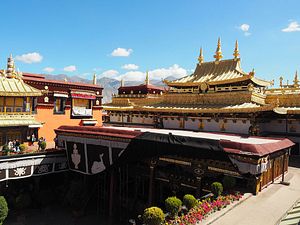On February 17 — one day after the Tibetan New Year or Losar, the most important traditional festival for Tibetans — a fire broke out in Lhasa’s Jokhang Temple, one of the holiest and most politically sensitive sites in Tibet.
A number of netizens immediately posted pictures and videos as well as prayers on their social media platforms. Some of those video clips showed flames burning above the golden roof of the holy temple, while several firefighters climbed high on the wall of the temple to extinguish the blaze and people in the background shouted or cried.
These posts were soon wiped from Chinese social media by censors.
Instead, China’s state news agency, Xinhua, released a short announcement late at night, saying that the fire, which “broke out at 6:40 pm,” was “soon put out,” with no deaths or injuries. But neither Xinhua nor any other Chinese media outlets released any further detail on the accident for days.
Unsurprisingly, the information vacuum made many Tibetans even more anxious, since the Jokhang Temple “is seen as the most sacred shrine in Tibetan Buddhism, and for centuries it’s been the focal point of pilgrimage for Tibetan Buddhists,” as Robert Barnett, a London-based expert on contemporary Tibet, told The New York Times.
Barnett also told The Guardian that Beijing’s “almost total suppression of information” had made many Tibetans feared the holy temple had suffered significant damage.
On February 18, the Tibet Daily — the official newspaper run by Tibet’s local government — published an article, titled “All ethnic groups celebrate the New Year holiday; Lhasa is in peace and harmony” through its social media account.
In the article, the Daily released several pictures of the Jokhang Temple’s interior and exterior, claiming that all the pictures were taken the morning of February 18 (after the fire). In these pictures, the holy site, which was open to the public, was crowded with devotees, and no damage can be seen within the main building.
But one anonymous source told Radio Free Asia that “yellow draperies had been newly hung behind the temple’s central image, the famous Jowo statue of the Buddha brought to Tibet in the seventh century by the Chinese bride of the Tibetan emperor Songtsen Gampo” and “no one was allowed to go up to the second floor of the temple.”
On February 22, Xinhua released a much more detailed report on the fire, saying that “a preliminary investigation has ruled out any human factors in the fire.” Xinhua made a point of noting that “the life-sized statue of the Sakyamuni Buddha when he was 12 years old [the Jowo statue] was intact.”
According to the Xinhua report:
The fire broke out on the second floor of the rear part of the sacred monastery at 6:40 Saturday evening and was soon put out. An area of about 50 square meters was burned.
The golden top has been removed in case of collapse or reburning. Protective supports and clapboards have been erected around the statue.
The regional cultural relics bureau said all the registered 6,510 cultural relics and the main building were intact.
The fire broke out in the ventilating chamber, which was built in late 1980s. No cultural relics were stored inside the chamber.
The same report in Chinese revealed more detail than the English version. The Chinese version quoted several local Tibetans — including one vice mayor, one local cultural affairs bureau official, one fire brigade official, and one monk of the temple — to demonstrate its authenticity.
However, many Tibetans still highly doubt Xinhua’s latest report.
Tsering Woeser, a well-known Tibetan writer and activist, posted on her Twitter account a notification released by China’s public security ministry on February 18. The notification — originally posted online by the Institute of Fire Science and Engineering, Nanjing Tech University — revealed more information on the Jokhang Temple fire, and some of the information seemed to contradict Xinhua’s reports, particularly regarding the start time and location of the blaze.
The four-page notification said:
At 19:06 on February 17, Lhasa’s Fire Brigade received an alarm that a fire broke out in the Jokhang Temple. The brigade immediately deployed 37 fire engines and more than 200 officers and firefighters to the scene. At 19:07, the firefighters on duty at the scene had already rushed to the main hall of the Jokhang Temple and took full efforts to extinguish the fire and rescue artifacts. At 20:05, the fire was extinguished and an area of about 50 square meters was burned, with no casualties.
The notification claimed that the leaders of the public security ministry attached great importance to this accident. Minister Zhao Kezhi specifically instructed local authorities to find out the cause of the fire and to “do a good job on social control.”
The notification further demanded that all local authorities across the country should carry out a specific inspection to eliminate fire hazards in religious temples and historical sites.

































